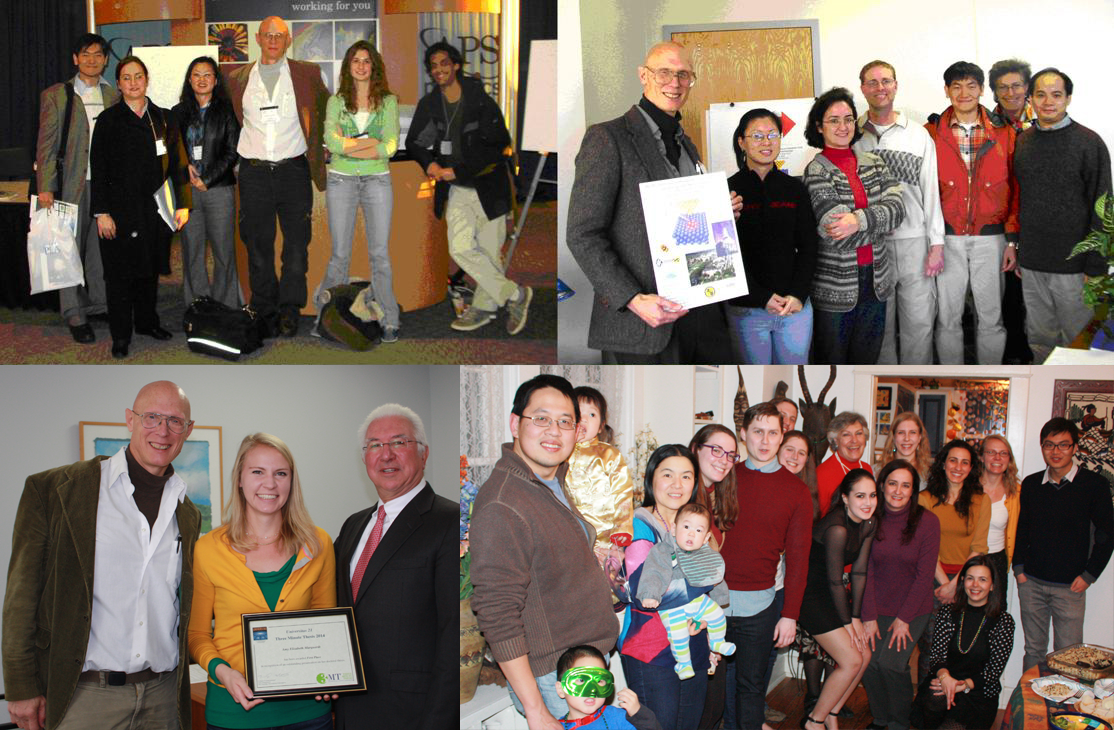 Image (top left): APS March Meeting 2006 – Sherman Guo, Tabassom Tadayyon-Eslami, TaesoonKwon, RJP, Erin Flanagan, Dominic Britti; top right: NSS3,2004: RJP, Taesoon Kwon, Tabassom Tadayyon-Eslami, Tim Corrigan, Sherman Guo, CristinaLoglio, Hung-Chih Kan; bottom, left: 3MT Award presentation to Amy Maququardt, 2015: RJP, Amy Maquardt, Dean Charles Caramello, RJP; bottom right, Informal Group Party.
Image (top left): APS March Meeting 2006 – Sherman Guo, Tabassom Tadayyon-Eslami, TaesoonKwon, RJP, Erin Flanagan, Dominic Britti; top right: NSS3,2004: RJP, Taesoon Kwon, Tabassom Tadayyon-Eslami, Tim Corrigan, Sherman Guo, CristinaLoglio, Hung-Chih Kan; bottom, left: 3MT Award presentation to Amy Maququardt, 2015: RJP, Amy Maquardt, Dean Charles Caramello, RJP; bottom right, Informal Group Party.
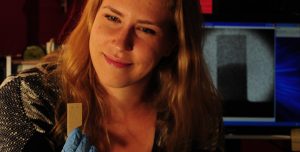 Miriam (Mimi) Hiebert is a third-year graduate student in the Department of Materials Science and Engineering. Mimi is carrying out investigations on the application of atomic layer deposited films for the mitigation of glass disease in historic glass. She has a Big 10 fellowship, which supports her work with our collaborator Ed Vicenzi at the Smithsonian Institutions Museum Conservation Institute (SI-MCI) employing microanalytical techniques at quantifying the performance of ALD in slowing the ion exchange between glass and water. Mimi also uses neutron radiography to examine hydration profiles within cultural heritage materials, and is collaborating with NRC PostdocJamie Weaver at NIST employing neutron techniques in measuring the formation of hydrated layers within treated glass samples.
Miriam (Mimi) Hiebert is a third-year graduate student in the Department of Materials Science and Engineering. Mimi is carrying out investigations on the application of atomic layer deposited films for the mitigation of glass disease in historic glass. She has a Big 10 fellowship, which supports her work with our collaborator Ed Vicenzi at the Smithsonian Institutions Museum Conservation Institute (SI-MCI) employing microanalytical techniques at quantifying the performance of ALD in slowing the ion exchange between glass and water. Mimi also uses neutron radiography to examine hydration profiles within cultural heritage materials, and is collaborating with NRC PostdocJamie Weaver at NIST employing neutron techniques in measuring the formation of hydrated layers within treated glass samples.
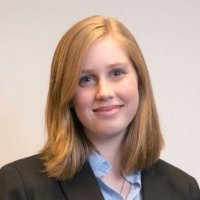 Caroline Zellhofer is a second year-graduate student in the Department of Materials Science and Engineering, working on the application of atomic layer deposited films in retarding the degradation of cellulose acetate, a polymer alsoic cultural heritage material used in consumer products, due to water-enabled deacetylization. She started working on this project with Dr. Odile Madden, at SI-MCI, who has recently moved on to the conservation department at the Getty Museum.
Caroline Zellhofer is a second year-graduate student in the Department of Materials Science and Engineering, working on the application of atomic layer deposited films in retarding the degradation of cellulose acetate, a polymer alsoic cultural heritage material used in consumer products, due to water-enabled deacetylization. She started working on this project with Dr. Odile Madden, at SI-MCI, who has recently moved on to the conservation department at the Getty Museum.
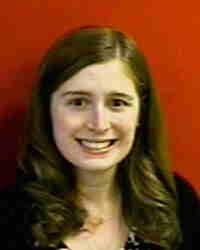 Laura Jean Weidman is a third year-graduate student in the Department of Materials Science and Engineering, who is studying the aging of lead-tin solder for forensic studies of circuit boards, as a means of determining the time elapsed since they were assembled. She collaborates with Dr. Kil-Won Moon at NIST in sample preparation techniques, and with Dr. Dale Newbury in the use of Energy Dispersive X-Ray Fluorescence analysis of the tin content in the beta phase of eutectic solder vs. time and processing/aging. She is the Programming Officer for the Washington Chapter of ASM. Laura Jean received her MS degree in Materials Science and Engineering at the University of Maryland in 2017.
Laura Jean Weidman is a third year-graduate student in the Department of Materials Science and Engineering, who is studying the aging of lead-tin solder for forensic studies of circuit boards, as a means of determining the time elapsed since they were assembled. She collaborates with Dr. Kil-Won Moon at NIST in sample preparation techniques, and with Dr. Dale Newbury in the use of Energy Dispersive X-Ray Fluorescence analysis of the tin content in the beta phase of eutectic solder vs. time and processing/aging. She is the Programming Officer for the Washington Chapter of ASM. Laura Jean received her MS degree in Materials Science and Engineering at the University of Maryland in 2017.
Nicholas (Nick) Strnad is a fifth year-graduate student in the Department of Materials Science and 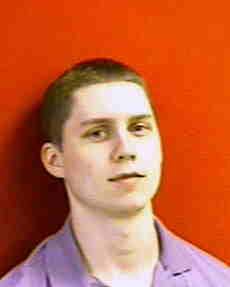 Engineering. Nick’s research involves using atomic layer deposition to produce piezoelectric films based upon lead zirconium titinate (PZT) as well as lead titinate. Nick carries out his research as a Deposition Engineer at the Army Research Laboratories (ARL) in Adelphi, collaborating with the group of Ron Polcawich. He has presented his results at poster sessions at the 2016 AVS ALD Conference, the 2017 PiezoMEMS Workshop, and the 2018 AVS ALD Conference.
Engineering. Nick’s research involves using atomic layer deposition to produce piezoelectric films based upon lead zirconium titinate (PZT) as well as lead titinate. Nick carries out his research as a Deposition Engineer at the Army Research Laboratories (ARL) in Adelphi, collaborating with the group of Ron Polcawich. He has presented his results at poster sessions at the 2016 AVS ALD Conference, the 2017 PiezoMEMS Workshop, and the 2018 AVS ALD Conference.
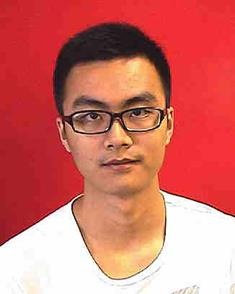 Ke (Kirk) Tang is a third year graduate student in the Department of Materials Science and Engineering. Kirk’s research is on the use of differential mobility analysis sorting of ions as an approach toward growing highly isotopically-refined 28Si as a means of increasing decoherence times for applications in quantum information technology. He carries out his work at NIST in Gaithersburg, in collaboration with the group of Dr. Josh Pomeroy.
Ke (Kirk) Tang is a third year graduate student in the Department of Materials Science and Engineering. Kirk’s research is on the use of differential mobility analysis sorting of ions as an approach toward growing highly isotopically-refined 28Si as a means of increasing decoherence times for applications in quantum information technology. He carries out his work at NIST in Gaithersburg, in collaboration with the group of Dr. Josh Pomeroy.
ALUMNA/ALUMNI
Dr. Amy Marquardt defended her PhD thesis “Novel protective coatings for silver and copper alloy cultural heritage objects using atomic layer 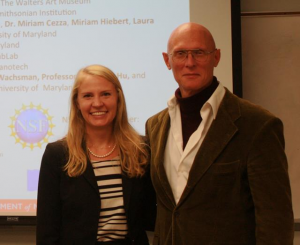 deposited metal oxide barrier films” in 2015. Amy’s research involved a new method for preserving silver and bronze alloy art and cultural heritage objects using atomic layer deposition (ALD) diffusion barriers. Coming up with a new conservation approach involved not only protecting cultural heritage objects from corroding, but also adhering to the strict requirements of art conservation, which require the coatings to minimally change object appearance, have a long effective lifetime, and be completely reversible without significant substrate alteration. She demonstrated that ALD alumina films protect silver at least 15 times longer than cellulose nitrate films, for an expected lifetime of more than 150 years. She identified two thickness windows in which the films are nearly invisible to all but the most practiced eye. She also developed approaches for removing the films using weak solutions of NaOH-with only very minor compositional changes in AgCu alloys confined to the top 2-3 nm of the alloy surface. She published her work in Heritage Science, Bulletin of Engineering Geology and the Environment, and ECS Transactions. Amy won a series of prizes for her work, including the Universitas-21 international three minute video competition (http://www.universitas21.com/article/research/details/268/three-minutes-thesis-competition), a GEMS ‘Diamond’ ranking award a given by the American Ceramics Society (http://www.mse.umd.edu/news/news_story.php?id=8595), and a CIC-Smithsonian Fellowship. She is presently a postdoc at Northwestern University.
deposited metal oxide barrier films” in 2015. Amy’s research involved a new method for preserving silver and bronze alloy art and cultural heritage objects using atomic layer deposition (ALD) diffusion barriers. Coming up with a new conservation approach involved not only protecting cultural heritage objects from corroding, but also adhering to the strict requirements of art conservation, which require the coatings to minimally change object appearance, have a long effective lifetime, and be completely reversible without significant substrate alteration. She demonstrated that ALD alumina films protect silver at least 15 times longer than cellulose nitrate films, for an expected lifetime of more than 150 years. She identified two thickness windows in which the films are nearly invisible to all but the most practiced eye. She also developed approaches for removing the films using weak solutions of NaOH-with only very minor compositional changes in AgCu alloys confined to the top 2-3 nm of the alloy surface. She published her work in Heritage Science, Bulletin of Engineering Geology and the Environment, and ECS Transactions. Amy won a series of prizes for her work, including the Universitas-21 international three minute video competition (http://www.universitas21.com/article/research/details/268/three-minutes-thesis-competition), a GEMS ‘Diamond’ ranking award a given by the American Ceramics Society (http://www.mse.umd.edu/news/news_story.php?id=8595), and a CIC-Smithsonian Fellowship. She is presently a postdoc at Northwestern University.
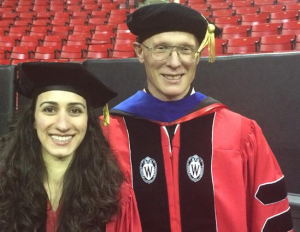 Dr. Miriam Cezza defended her PhD thesis “Study Of The Feasibility Of Controlling The Length Scale Of The Phase Separation Of Organic Molecular Mixtures On Si(111) Substrates” in 2014. Miriam studied as a prototypical system for directing molecular phase separation mixtures of [6,6]-phenyl-C61-butyric acid methyl ester (PCBM), an electron acceptor, and tetranitro Zninc phthalocyanine, and electron donor in chloroform solution, deposited onto native oxide-covered Si(111) substrates. She found the morphology of PCBM molecule domains varies widely depending on solvent evaporation rate, the presence/absence of a second solute, tn-ZnPc, in the solution, and seemingly the presence/absence of trace impurities. She found that the domain morphology of tn-ZnPc was insensitive to evaporation rate, but that the larger scale assembly of multiple domains varied according to rate of evaporation, and even substrate orientation. Miriam was lead author on a paper published in Langmuir, entitled, “Assembly of PCBM and tn-ZnPc molecular domains and phase separation of molecular mixtures from liquid solution on Si (111),” and has two other papers in preparation. She presented her work at the APS March Meeting and was a competitor for the Nottingham Prize at the Physical Electronics Conference. She is presently a process engineer at Intel in Portland, Oregon.
Dr. Miriam Cezza defended her PhD thesis “Study Of The Feasibility Of Controlling The Length Scale Of The Phase Separation Of Organic Molecular Mixtures On Si(111) Substrates” in 2014. Miriam studied as a prototypical system for directing molecular phase separation mixtures of [6,6]-phenyl-C61-butyric acid methyl ester (PCBM), an electron acceptor, and tetranitro Zninc phthalocyanine, and electron donor in chloroform solution, deposited onto native oxide-covered Si(111) substrates. She found the morphology of PCBM molecule domains varies widely depending on solvent evaporation rate, the presence/absence of a second solute, tn-ZnPc, in the solution, and seemingly the presence/absence of trace impurities. She found that the domain morphology of tn-ZnPc was insensitive to evaporation rate, but that the larger scale assembly of multiple domains varied according to rate of evaporation, and even substrate orientation. Miriam was lead author on a paper published in Langmuir, entitled, “Assembly of PCBM and tn-ZnPc molecular domains and phase separation of molecular mixtures from liquid solution on Si (111),” and has two other papers in preparation. She presented her work at the APS March Meeting and was a competitor for the Nottingham Prize at the Physical Electronics Conference. She is presently a process engineer at Intel in Portland, Oregon.
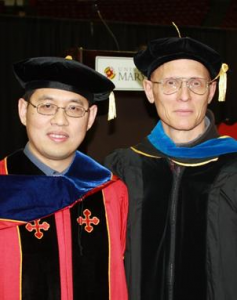 Dr. Chuan-Fu Lin defended his PhD thesis, “Directed Self-Assembly of Nanostructures and The Observations of Self-Limiting Growth of Mounds on Patterned Crystal Surface during Epitaxial Growth” in 2012. Chuan-Fu carried out detailed kinetic Monte Carlo (kMC) simulations of the effect of an ‘extra’ diffusion barrier at step edges (Ehrlich-Schwoebel barrier) on epitaxial growth in the presence of an artificially defined template in directing the assembly of a series of higher-order commensurate arrangements of nm-scale growth mounds. He carried out molecular beam epitaxial (MBE) GaAs on patterned GaAs(001) growth experiments that that confirmed this behavior. He also found evidence for self-limiting behavior in this system, seemingly due to a sharpening of the mounds during growth, and a minimum critical terrace size for nucleation of additional terraces. Chuan Fu published his results in: XXX, YYY and ZZZ, and presented these results at the APS March Meeting, as well as the Physical Electronics Conference where he competed for the Nottingham Prize. He is presently a Research Scientist at the University of Maryland, applying ALD to improving Li-ion battery technology.
Dr. Chuan-Fu Lin defended his PhD thesis, “Directed Self-Assembly of Nanostructures and The Observations of Self-Limiting Growth of Mounds on Patterned Crystal Surface during Epitaxial Growth” in 2012. Chuan-Fu carried out detailed kinetic Monte Carlo (kMC) simulations of the effect of an ‘extra’ diffusion barrier at step edges (Ehrlich-Schwoebel barrier) on epitaxial growth in the presence of an artificially defined template in directing the assembly of a series of higher-order commensurate arrangements of nm-scale growth mounds. He carried out molecular beam epitaxial (MBE) GaAs on patterned GaAs(001) growth experiments that that confirmed this behavior. He also found evidence for self-limiting behavior in this system, seemingly due to a sharpening of the mounds during growth, and a minimum critical terrace size for nucleation of additional terraces. Chuan Fu published his results in: XXX, YYY and ZZZ, and presented these results at the APS March Meeting, as well as the Physical Electronics Conference where he competed for the Nottingham Prize. He is presently a Research Scientist at the University of Maryland, applying ALD to improving Li-ion battery technology.
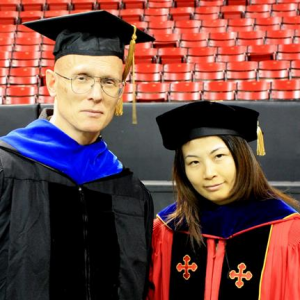 Dr. Shu-Ju (Phoebe) Tsai defended her thesis, “Spectroscopic Enhancement from Noble Metallic Nanoparticles” in 2010. Phoebe’s research involved the use of size selected noble metal nanoparticles to enhance the interaction of molecules and light. She has been working with Sherman Guo and De-Hao Tsai on experiments on nanoparticle-enhanced fluorescence, in this case employing size selected particles fabricated by spray pyrolysis and differential mobility analysis, and deposited onto a silicon substrate. Phoebe has also developed numerical simulations based upon the dynamic dipole approximation which show that the substrate plays an active role in the enhancement, reshaping the distribution of intense electric field during illumination with light. Phoebe gave a talk at the 2007 APS March Meeting in Denver, and published papers on the effect of an active substrate on fluorescence enhancement in Advanced Materials, and on the effect of plasmonic gold nanopillararrays in a bulk heterojunction organic solar cells in Optics Express and in Energies. She is presently an Assistant Research Fellow at the Center for Micro/Nano Science and Technology at National Cheng Kung University in Taiwan.
Dr. Shu-Ju (Phoebe) Tsai defended her thesis, “Spectroscopic Enhancement from Noble Metallic Nanoparticles” in 2010. Phoebe’s research involved the use of size selected noble metal nanoparticles to enhance the interaction of molecules and light. She has been working with Sherman Guo and De-Hao Tsai on experiments on nanoparticle-enhanced fluorescence, in this case employing size selected particles fabricated by spray pyrolysis and differential mobility analysis, and deposited onto a silicon substrate. Phoebe has also developed numerical simulations based upon the dynamic dipole approximation which show that the substrate plays an active role in the enhancement, reshaping the distribution of intense electric field during illumination with light. Phoebe gave a talk at the 2007 APS March Meeting in Denver, and published papers on the effect of an active substrate on fluorescence enhancement in Advanced Materials, and on the effect of plasmonic gold nanopillararrays in a bulk heterojunction organic solar cells in Optics Express and in Energies. She is presently an Assistant Research Fellow at the Center for Micro/Nano Science and Technology at National Cheng Kung University in Taiwan.
Dr. Tsung-Cheng (T. C.) Lin defended his thesis, “Nanomechanical properties and buckling instability of plasma induced damaged layer on 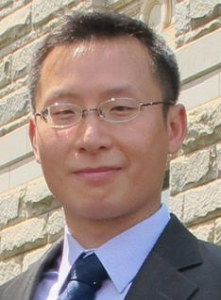 polystyrens,” in 2012. T. C.’s research involved studying the stability of prototype resists against roughening during reactive ion etching, as part of the National Science Foundation Nanoscience Interdisciplinary Research Team (NIRT) project which we carried out in collaboration with Professor Gottlieb Oehrlein’s group at the UM, Professor David Graves’ group at UC-Berkeley, Professor Grant Willsons’ group at UT-Austin, and Azar Alizehda at General Electric. T. C. used a nanopatterning approach toward probing the stability of the plasma-resist interface, and in studying its relaxation. He published papers in Applied Physics Letters, Journal of Vacuum Science and Technology and Journal of Applied Physics. He is presently a Postdoctoral Researcher at Rice University.
polystyrens,” in 2012. T. C.’s research involved studying the stability of prototype resists against roughening during reactive ion etching, as part of the National Science Foundation Nanoscience Interdisciplinary Research Team (NIRT) project which we carried out in collaboration with Professor Gottlieb Oehrlein’s group at the UM, Professor David Graves’ group at UC-Berkeley, Professor Grant Willsons’ group at UT-Austin, and Azar Alizehda at General Electric. T. C. used a nanopatterning approach toward probing the stability of the plasma-resist interface, and in studying its relaxation. He published papers in Applied Physics Letters, Journal of Vacuum Science and Technology and Journal of Applied Physics. He is presently a Postdoctoral Researcher at Rice University.
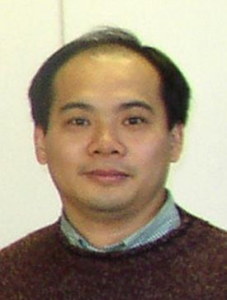 Dr. Hung-Chih Kan was a graduate student, then postdoc, and later a Research Scientist in my group. His research with my group included: experimental investigation on enhancement of fluorescence from metallic nano-particles and numerical simulation for surface plasmonic resonance from nano-particles to probe the physical process that causes the enhancement of the fluorescence. He also worked on experimental studies of
Dr. Hung-Chih Kan was a graduate student, then postdoc, and later a Research Scientist in my group. His research with my group included: experimental investigation on enhancement of fluorescence from metallic nano-particles and numerical simulation for surface plasmonic resonance from nano-particles to probe the physical process that causes the enhancement of the fluorescence. He also worked on experimental studies of
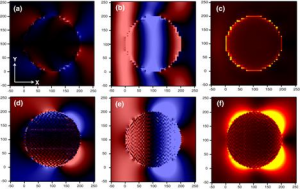
Electric field distribution for a silver nano-particle with diameter of 200nm in the presence of a light wave propagating in the +x direction, with the E field initially polarized in the +y direction. The wave length for the incident light is 200 nm for (a)-(c), and 400nm for (e)-(f). According to the simulation the maximum extinction (resonance) occurs at 400nm wavelength. Panel (a) and (d) show the X component of the E-field, (b) and (e) the Y component, and (c) and (f) the E2. Color levels for (a),(b),(d) and (e): red for positive, blue for negative, and black indicated zero level. For (c) and (f), black indicates 0 (V/cm) 2, and bright yellow for 10 (V/cm) 2.
evolutions of patterned semiconductor surfaces under processing conditions, such as homo-epitaxial growth or high temperature annealing, as potential recipe for directed self-organization for nano-scale fabrication, and performed simulation to provide explanation for the experimental observations. He joined the Physics Department at National Chung Cheng University in Taiwan as an Associate Professor, and was promoted to full professor in 2017. He continues to collaborate with our group as a Visiting Professor.
Dr. Taesoon Kwon defended her thesis Evolution of patterned and unpatterned surfaces during high temperature annealing and plasma etching in 2007. Taesoon’s research involved patterning for self-organization during 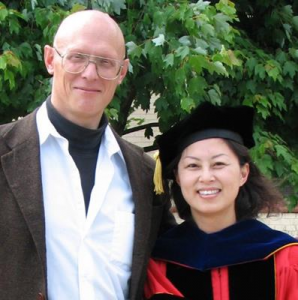 annealing and reactive ion etching of materials of great technological interest for the semiconductor industry: silicon, nanoporous silica and model resists. Her research also included a study the stability of prototype resists against roughening during reactive ion etching, as part of the National Science Foundation Nanoscience Interdisciplinary Reseach Team (NIRT) project which we are carrying out in collaboration with Professor Gottlieb Oehrlein’s group at the UM, Professor David Graves’ group at UC-Berkeley, Professor Grant Willsons’ group at UT-Austin, and Azar Alizehda at General Electric. Taesoon published papers in Applied Physics Letters, Nanotechnology and Journal of Vacuum Science and Technology B, and gave talks at the American Physical Society March Meeting, the American Vacuum Society Symposium and The Physical Electronics Conference. Since finishing her PhD she has worked as a process engineer, first at Micron, then at Global Foundries, and now at IBM.
annealing and reactive ion etching of materials of great technological interest for the semiconductor industry: silicon, nanoporous silica and model resists. Her research also included a study the stability of prototype resists against roughening during reactive ion etching, as part of the National Science Foundation Nanoscience Interdisciplinary Reseach Team (NIRT) project which we are carrying out in collaboration with Professor Gottlieb Oehrlein’s group at the UM, Professor David Graves’ group at UC-Berkeley, Professor Grant Willsons’ group at UT-Austin, and Azar Alizehda at General Electric. Taesoon published papers in Applied Physics Letters, Nanotechnology and Journal of Vacuum Science and Technology B, and gave talks at the American Physical Society March Meeting, the American Vacuum Society Symposium and The Physical Electronics Conference. Since finishing her PhD she has worked as a process engineer, first at Micron, then at Global Foundries, and now at IBM.
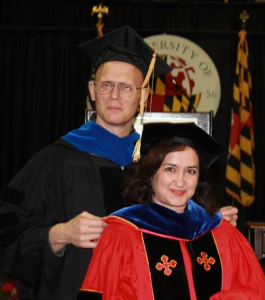 Dr. Tabassom Tadayyon-Eslami defended her thesis, “Temperature dependence of the growth mode during homoepitaxy on patterned gallium arsenide (001); atomic-scale mechanisms for unstable growth,” in 2006. Tabassom’s research involved investigations of the length- scale dependence of unstable growth on patterned GaAs(001). In this work, she employed photolithography and reactive ion etching to create arrays of cylindrical pits on the surface, whose size and spacing are varied in a combinatorial manner. She found that there is a transient instability during molecular beam epitaxial (MBE) growth at standard conditions, and that the nature of this instability changes qualitatively upon lowering the temperature through a value which approximately coincides with that of thermodynamic preroughening. She established that this was coincidental, however, and identified atom-scale mechanisms which explain the instability and its temperature dependence. She published papers in Physical Review Letters, Physical Review B and Applied Physics Letters based upon this work, and gave talks on it at the APS March Meeting and competed for the Nottingham Prize at the Physical Electronics Conference. Tabassom is presently working at the US patent office in Arlington, VA.
Dr. Tabassom Tadayyon-Eslami defended her thesis, “Temperature dependence of the growth mode during homoepitaxy on patterned gallium arsenide (001); atomic-scale mechanisms for unstable growth,” in 2006. Tabassom’s research involved investigations of the length- scale dependence of unstable growth on patterned GaAs(001). In this work, she employed photolithography and reactive ion etching to create arrays of cylindrical pits on the surface, whose size and spacing are varied in a combinatorial manner. She found that there is a transient instability during molecular beam epitaxial (MBE) growth at standard conditions, and that the nature of this instability changes qualitatively upon lowering the temperature through a value which approximately coincides with that of thermodynamic preroughening. She established that this was coincidental, however, and identified atom-scale mechanisms which explain the instability and its temperature dependence. She published papers in Physical Review Letters, Physical Review B and Applied Physics Letters based upon this work, and gave talks on it at the APS March Meeting and competed for the Nottingham Prize at the Physical Electronics Conference. Tabassom is presently working at the US patent office in Arlington, VA.
Dr. Jeong-Young Park is a former Postdoctoral researcher with our group. His work with us involved the use of the scanning tunneling microscope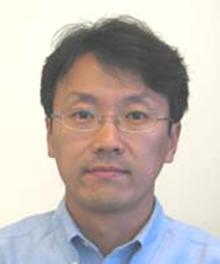
in probing the time response of working device structures and in creating and modifying nanostructures at surfaces. Jeong-Young has published papers in Science, Applied Physics Letters, Journal of Vacuum Science and Technology and Surface Science. He is now a Research Scientist at Lawrence Berkeley Laboratories carrying out studies on hot electron generation from catalytic reaction in catalytic nanodiode, atomic or molecular scale properties of surface and interface, nanotribological properties of quasicrystal surface and their relation with the surface atomic structure, and charge transport properties and mechanical properties in organic molecules or bio-materials with conductive atomic force microscopy.
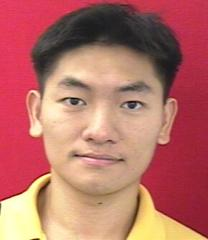 Dr. Shy-Hauh (Caleb) Guo got his PhD in Electrical and Computer Engineering on “The Role of Plasmonic Resonance in Enhancement of Interaction of Light and Silver Nanostructures in Fluorescence” in 2009. Shy-Hauh used electron beam lithography to create arrays of silver and gold nanoparticle whose size shape and spacing are varied in a combinatorial manner to tune the particle plasmon resonance. He has been studying the underlying mechanisms for nanoparticle-enhanced fluorescence from nearby fluorescently-tagged molecules, which he measured with scanned fluorescence microscopy. He has also developed numerical simulations of the electric field around arrays of nanoparticles, based upon the finite difference time domain method (FDTD). Sherman published papers in Advanced Materials, Applied Physics Letters, the Journal of Fluorescence, and gave talks at the APS March Meeting and the Physical Electronics Conference. He is presently a product engineer at Thorlabs specializing in instrumentation for fluorescence microscopy.
Dr. Shy-Hauh (Caleb) Guo got his PhD in Electrical and Computer Engineering on “The Role of Plasmonic Resonance in Enhancement of Interaction of Light and Silver Nanostructures in Fluorescence” in 2009. Shy-Hauh used electron beam lithography to create arrays of silver and gold nanoparticle whose size shape and spacing are varied in a combinatorial manner to tune the particle plasmon resonance. He has been studying the underlying mechanisms for nanoparticle-enhanced fluorescence from nearby fluorescently-tagged molecules, which he measured with scanned fluorescence microscopy. He has also developed numerical simulations of the electric field around arrays of nanoparticles, based upon the finite difference time domain method (FDTD). Sherman published papers in Advanced Materials, Applied Physics Letters, the Journal of Fluorescence, and gave talks at the APS March Meeting and the Physical Electronics Conference. He is presently a product engineer at Thorlabs specializing in instrumentation for fluorescence microscopy.
